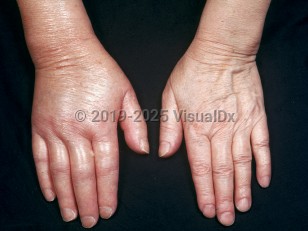Thromboangiitis obliterans
Alerts and Notices
Important News & Links
Synopsis

Although the number of cases in the United States has declined along with the decreased per capita rate of smoking, the incidence was estimated to be between 12 and 20 per 100 000 people in the early 2000s. The disease is most prevalent in Asia and the Far and Middle East. There is a genetic predisposition as certain human leukocyte antigen (HLA) class I and class II alleles have been associated with an increased risk of disease. Susceptible individuals seem to have an abnormal autoimmune reaction of the endothelium upon tobacco exposure. The stages of change in the vessel begin with thrombus formation in response to vascular inflammation, followed by occlusion and microabscess formation, granulomatous change, and ultimately reorganization and recanalization of the vessel.
Affected individuals initially experience both upper and, more commonly, lower extremity claudication distally. They may also experience pain and paresthesia. It is not uncommon to affect multiple extremities, and more severe disease leads to pain at rest and ischemic ulceration that may progress to gangrene and amputation.
Superficial thrombophlebitis is also seen in TAO. Joint involvement with recurrent arthritic symptoms of the large joints can precede the occlusive phase and make early diagnosis difficult. Intestinal involvement with abdominal pain, diarrhea, and even frank melena may rarely occur. There have been rare case reports of scrotal and penile involvement.
Codes
I73.1 – Thromboangiitis obliterans [Buerger's disease]
SNOMEDCT:
52403007 – Thromboangiitis obliterans
Look For
Subscription Required
Diagnostic Pearls
Subscription Required
Differential Diagnosis & Pitfalls

Subscription Required
Best Tests
Subscription Required
Management Pearls
Subscription Required
Therapy
Subscription Required
Drug Reaction Data
Subscription Required
References
Subscription Required
Last Updated:01/30/2025

